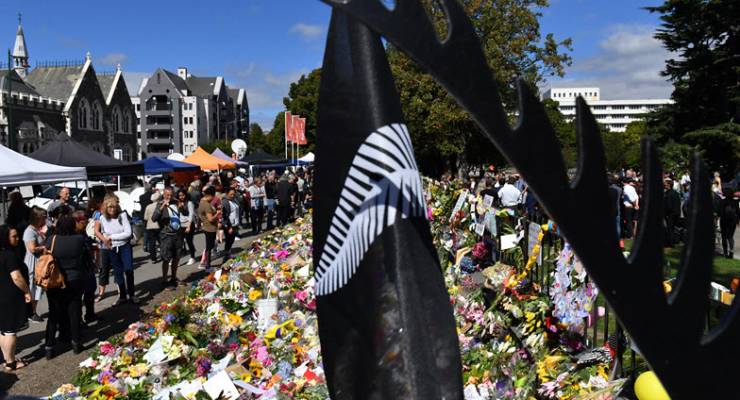
We strongly urge you to take a principled stand in your future coverage of mass killers that could potentially save lives:
1. Don’t name the perpetrator.
2. Don’t use photos or likenesses of the perpetrator.
3. Stop using the names, photos, or likenesses of past perpetrators.
4. Report everything else about these crimes in as much detail as desired.An open letter to US media outlets, co-signed by 147 academics, law enforcement officials and public health experts, October 3, 2017.
He is a terrorist. He is a criminal. He is an extremist. But he will, when I speak, be nameless. And to others, I implore you: speak the names of those who were lost rather than the name of the man who took them. He may have sought notoriety but we, in New Zealand, will give nothing — not even his name.
New Zealand Prime Minister Jacinda Ardern, March 19, 2019.
In the aftermath of the October 2017 massacre in Las Vegas, I spoke to one of the world’s preeminent forensic psychiatrists Emeritus Professor Paul Mullen. Among other things, Mullen interviewed the perpetrators of the Port Arthur and Hoddle Street massacres (and during our conversation was able, with no loss of clarity, to avoid using either of their names). The perpetrator of Port Arthur, he told me, was not an intelligent man (“He was thick as two short planks,” was how Mullen put it). There was one subject, however, on which he was an encyclopedia: other mass shooters. “He knew everything about them.”
This is invariably true of mass shooters; they are inspired by the fame and notoriety of one another.
A lot of the commentary since the Christchurch massacre has (necessarily, and appropriately) focused on the mainstreaming of white supremacist talking points that has occurred in the past 20 years, and the media’s responsibility in giving a platform to explicit or implicit white supremacists. Less focus has fallen on what responsibility the media has in spreading his name, image and ideas.
This is despite vast evidence that the way we traditionally cover mass shootings has a “social contagion” effect.
The Christchurch shooter has, since his grotesque act of mass murder in a place of worship, had his face plastered on the front pages of Adelaide’s The Advertiser, The Weekend West, The Daily Telegraph, The Courier Mail and the Herald Sun. His name has been repeated throughout reports (including in Crikey), his childhood raked over and his family interviewed, his putative “manifesto” read aloud on television, and, most grotesque of all, had the live stream of his attack played on television and embedded in online articles. This, as we know, is just what he wanted.
For all that is seemingly new about him — particularly the “shitposting”, in-joke filled “manifesto” he posted online and emailed to Ardern before the atrocity — what we know of the shooter seems to tick a lot of the boxes that typify a mass shooter, as years of research have established:
- It appears he is not psychotic (most research indicates that a little over one in 10 mass shooters actually has a psychotic disorder).
- His final post on 8chan suggested he was ready to die (“Mass shooters invariably intend to die among their victims,” Mullen told Crikey).
- His manifesto directly said he was inspired by the “writings” of other white supremacist mass shooters.
The Christchurch terrorist also followed what Mullen calls the “cultural script” around mass shootings. Importantly, the fact that his motive was terrorism didn’t change the script he was following.
Indeed, Mullen said there was very little to distinguish between the psychological profile of men who carry out politically motivated terror attacks and those who perpetrate seemingly “random” mass shootings.
“When you study these people, they are remarkably similar,” he said. “They are loners, obsessive, eaten by similar resentments and grievances, suicidal and looking to vindicate their lives through an act of violence that will give them fame and notoriety. The white supremacy element would just be another way of boosting his sad little ego.”
Journalist and lecturer Glynn Greensmith, whose PhD examines the local media coverage of the Dunblane (Scotland) and Port Arthur massacres, has been writing about the link between media coverage and mass shootings for years — asking media outlets not to name or show images of mass shooters. As news of Christchurch first filtered through, he wrote a piece asking that people not share the killer’s manifesto.
“There are no answers in that manifesto — except perhaps that he knows you will broadcast it,” he told Crikey. “If he knew, in advance, that no one would publish or discuss his manifesto, would that have changed things?”
Las Vegas remains the worst mass shooting, in terms of numbers, in US history. Coverage of that massacre (as it always does) delved into the shooter’s family, his relationship, the “meticulous” planning of the event — not to mention details of the weapons he used and his method of suicide — anything that might give a clue as to why this happened. Greensmith argues Las Vegas is a perfect illustration of the folly of media that focuses on the perpetrator.
“‘Why?’ is a perfectly understandable question — but I double dare anyone, after all that, to tell me why Las Vegas happened,” he said. “If anyone answers that question, it’s forensic scientists, criminologists, and it takes them years. It’s not journalists, a few days later.”
Yesterday, it was reported that a self-described copycat, using the same language (“invaders”) as the Christchurch killer, posted a threat on social media that he would commit a mass shooting against a Victorian mosque — ending with the promise to shoot themselves in front of police. Whether they intended to act on this is almost irrelevant — they were following the script to the letter.








I don’t entirely believe the theory of your self-censored reporting as a preventative measure against further mass murder.
The reality is that resentful, socially isolated individuals seek support with their own kind and that is much more likely via online chatrooms where they can interact and feed each others delusions, its unlikely that Crikey / MSM has any significant influence.
Imitation or copycat incidents of any publicly harmful and illegal act are far more frequent when its possible for the imitator to remain unknown, for example the needle in Strawberry’s mania that gripped Australia in the recent past. I saw no media concern about contributing to the occurrence of those copycat incidents?
It was festering resentful violence, plus access to weapons capable of inflicting mass murder that were the major enabling factors in the Christchurch killings.
Violence will always be a part of the human makeup. The prohibition of weapons solely designed for automatic rapid fire is the failure of NZ government’s past and present.
It took Port Arthur in Australia and likely this mass murder in NZ to prohibit access…. but it seems nothing will convince the USA.
Thanks for an informative article.
As an aside I can’t help but notice how the perpetrators of the Hoddle Street, Port Arthur and Christchurch mass shootings did all live to be interviewed so that we are able to know about their encyclopaedic knowledge of previous mass shootings. The police deserve credit for this fact.
There is no doubt that many acts of terrorism are theatrical productions on the same script, with actors from the street being effectively invited to apply for the main roles. However their power to terrorise their audience does require the audience being willing to be terrorised.
Doesn’t a horror play require us to be willing to be horrified? We could just shrug off the temptation and walk away before the play even begins.
Lacking enthusiastic co-actors, a would-be terrorist act would fall short of the planned drama. Probably bloody and multiple casualties, but no more than an ugly crime to be dealt with by the police and judiciary, leaving the front page to be occupied by more important matters.
I noticed comment on conspiracy-watch sites that suggested that the shooting is fake. I watched 17 minutes of head-cam footage from the shooter. Is it real or fake? I’m not sure but am far from convinced that it is real.
Still unsure about the moon landings too, are you?
Unbelievable that you would watch that death porn for any reason.
The only reason I now intend to watch it, if I can find it, is because of the extraordinary & unprecedented effort being put toward telling everyone not to watch it. I don’t really appreciate being told what not to do with my own eyeballs, and have no reason to trust that I am being somehow protected from anything. Nothing “porn” about it – I will take no pleasure from it.
This the reaction of a slow-witted 12 year old. . “I’m going to watch this because the grown-ups told me not to, but they’re not the boss of me, so there!!!”
Worst and most inaccurate and irrelevant paraphrase I’ve seen today.
Conspiracy watch sounds like reputable source.
Media self regulating when the motto is “if it bleeds, it leads”.